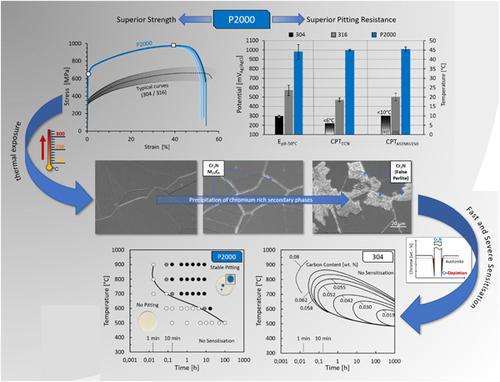当前位置:
X-MOL 学术
›
Mater. Corros.
›
论文详情
Our official English website, www.x-mol.net, welcomes your
feedback! (Note: you will need to create a separate account there.)
Application limits and sensitisation behaviour of the manganese- and nitrogen-alloyed austenitic stainless steel P2000 (X13CrMnMoN18-14-3)
Materials and Corrosion ( IF 1.6 ) Pub Date : 2021-05-13 , DOI: 10.1002/maco.202112450 Norman Kauss 1, 2 , Andreas Heyn 1 , Oliver Michael 1 , Michael Schymura 3 , Paul Rosemann 1, 4
Materials and Corrosion ( IF 1.6 ) Pub Date : 2021-05-13 , DOI: 10.1002/maco.202112450 Norman Kauss 1, 2 , Andreas Heyn 1 , Oliver Michael 1 , Michael Schymura 3 , Paul Rosemann 1, 4
Affiliation

|
Nickel-free high-nitrogen-alloyed stainless steels like the P2000 (X13CrMnMoN18-14-3) were developed to enhance the strength and corrosion resistance of austenitic stainless steels like 304 and 316 while keeping the typical high ductility. The mechanical and corrosive properties of P2000 were investigated and compared with 304 and 316 to highlight the application opportunities of this new alloy. The microstructure of the solution-annealed condition was characterised by electron backscatter diffraction and the mechanical properties were studied by uniaxial tensile tests, Charpy impact tests and hardness measurements. The passivation behaviour was analysed using the electrochemical potentiodynamic reactivation, whereas the pitting corrosion resistance was compared by pitting potentials and pitting temperatures. However, secondary thermal influences or suboptimal heat treatment can impair the corrosion resistance due to the precipitation of secondary phases and the resulting sensitisation. Thermodynamic calculations and artificial ageing treatment in the range of 500–900°C for up to 100 h were used to determine critical time–temperature parameters for sensitisation. The microstructure of the various aged states was evaluated by scanning electron microscopy and compared with the degrading corrosion resistance characterised by the KorroPad method.
中文翻译:

锰氮合金奥氏体不锈钢 P2000 (X13CrMnMoN18-14-3) 的应用限制和敏化行为
P2000 (X13CrMnMoN18-14-3) 等无镍高氮合金不锈钢的开发目的是提高 304 和 316 等奥氏体不锈钢的强度和耐腐蚀性,同时保持典型的高延展性。研究了 P2000 的机械和腐蚀性能,并与 304 和 316 进行了比较,以突出这种新合金的应用机会。固溶退火状态的微观结构通过电子背散射衍射表征,机械性能通过单轴拉伸试验、夏比冲击试验和硬度测量研究。使用电化学动电位再活化分析钝化行为,而通过点蚀电位和点蚀温度比较耐点蚀性。然而,二次热影响或次优热处理会由于二次相的沉淀和由此产生的敏化而削弱耐腐蚀性。使用热力学计算和在 500-900°C 范围内长达 100 小时的人工时效处理来确定敏化的关键时间-温度参数。通过扫描电子显微镜评估了各种时效状态的微观结构,并与 KorroPad 方法表征的降解耐蚀性进行了比较。
更新日期:2021-05-13
中文翻译:

锰氮合金奥氏体不锈钢 P2000 (X13CrMnMoN18-14-3) 的应用限制和敏化行为
P2000 (X13CrMnMoN18-14-3) 等无镍高氮合金不锈钢的开发目的是提高 304 和 316 等奥氏体不锈钢的强度和耐腐蚀性,同时保持典型的高延展性。研究了 P2000 的机械和腐蚀性能,并与 304 和 316 进行了比较,以突出这种新合金的应用机会。固溶退火状态的微观结构通过电子背散射衍射表征,机械性能通过单轴拉伸试验、夏比冲击试验和硬度测量研究。使用电化学动电位再活化分析钝化行为,而通过点蚀电位和点蚀温度比较耐点蚀性。然而,二次热影响或次优热处理会由于二次相的沉淀和由此产生的敏化而削弱耐腐蚀性。使用热力学计算和在 500-900°C 范围内长达 100 小时的人工时效处理来确定敏化的关键时间-温度参数。通过扫描电子显微镜评估了各种时效状态的微观结构,并与 KorroPad 方法表征的降解耐蚀性进行了比较。











































 京公网安备 11010802027423号
京公网安备 11010802027423号